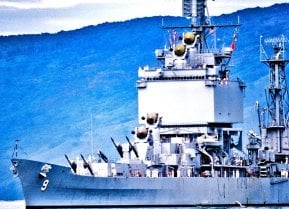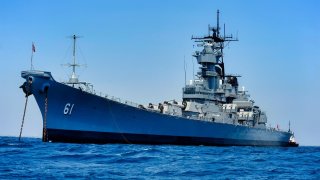Iowa-Class Battleship USS Iowa Is Getting Some Serious Upgrades
The USS Iowa (BB-61), a historic centerpiece of the Pacific Battleship Center in Los Angeles since 2012, epitomizes the largest and fastest class of battleships ever produced by the U.S. Navy.
Summary: The USS Iowa (BB-61), a historic centerpiece of the Pacific Battleship Center in Los Angeles since 2012, epitomizes the largest and fastest class of battleships ever produced by the U.S. Navy. Known for its significant role in World War II and the Korean War, this majestic warship, now a museum, continues to attract visitors with its storied past. Despite needing extensive deck repairs and facing financial challenges that have stalled relocation plans within the Port of Los Angeles, efforts are underway to maintain the USS Iowa for future generations, underscoring its enduring legacy as a symbol of American naval prowess.
USS Iowa: Preserving a Legendary Battleship as a Southern California Museum Marvel
The Battleship USS Iowa has been repeatedly ranked one of the top five museums in Southern California – and it serves to preserve the long-retired USS Iowa (BB-61), the lead vessel of the largest, fastest class of battleships ever produced for the United States Navy. The warship is the centerpiece of the Pacific Battleship Center, which has been open to the public in Los Angeles since 2012.
As with other retired warships, the former BB-61 is in need of much TLC, with major deck repair now in progress, yet, plans to relocate the ship to a more conducive location in the Port of Los Angeles are now on hold, as it would cost millions of dollars more than initially anticipated. For now, the USS Iowa will remain where it is, and hopefully continue to be maintained for future generations.
USS Iowa: A Historic Warship
The largest and most powerful battleships built for the U.S. Navy, the Iowa-class were also the final battleships that entered service with the Navy. Unlike slower battleships of the era, this class was also designed to travel with a carrier force, and even be able to transit the Panama Canal, enabling the mighty warships to respond to threats around the world.
Planning for the new class began even before the Japanese attack on Pearl Harbor. Seeing war clouds on the horizon, the U.S. Navy called for a "fast battleship" that could take on the increasing power projected by the Imperial Japanese Navy.
Laid down on June 6, 1940, she was completed on February 22, 1943 and just two days later was put to sea for a shakedown in the Chesapeake Bay and later along the Atlantic coast. By the summer of that year, she had been deployed to patrol the waters off the coast of Newfoundland after it was reported that the German battleship Tirpitz was operating in Norwegian waters.
In November 1943, USS Iowa carried President Franklin D. Roosevelt, along with Secretary of State Cordell Hull, Chief of Staff Admiral William D. Leahy, Chief of Staff of the Army General George C. Marshall, Chief of Naval Operations Ernest King, Commanding General of the U.S. Army Air Forces Henry "Hap" Arnold, Harry Hopkins, and other military leaders to Mers El Kébir, Algeria. It was the first leg of the journey for the leaders heading to the Tehran Conference, and the warship then conducted a similar presidential escort on the return journey in December.
Notably, the battleship was outfitted with a bathtub specifically for President Roosevelt, who was unable to use the warship's shower facilities.
She spent the rest of the Second World War in the Pacific, where USS Iowa took part in the Marshal and Mariana Islands Campaigns, the Okinawa Campaign, and in the summer of 1945 even took part in strikes on the Japanese home islands. Iowa joined her sister ship, USS Missouri (BB-63) during the September 2 surrender ceremony in Tokyo Bay, and BB-61 then remained in the bay as part of the occupying force.
Decommissioned in 1949, she returned to service just two years later and took part in the Korean War, serving as the flagship of the Seventh Fleet from April to October 1952. Iowa took part in shelling enemy positions on multiple occasions, including sorties north of the 38th parallel. Those actions established her eligibility for the United Nations Service Medal and the Korean Service Medal with one bronze star.
She was decommissioned a second time in 1958.
In the 1980s, when President Ronald Reagan called for a 600-ship U.S. Navy, the USS Iowa and her three battleships were reactivated and upgraded with new combat systems that replaced many of the ships' smaller five-inch guns with launchers for Harpoon anti-ship missiles, 32 Tomahawk cruise missiles and four Phalanx close-in weapon systems (CIWS). Initially equipped with 40mm anti-aircraft guns, during the Cold War those were replaced with missiles, electronic-warfare suites, and Phalanx anti-missile Gatling gun systems.
The warship was also used as the test bed for the Navy's RQ-2 Pioneer Unmanned Aerial Vehicle (UAV) in the 1980s, the first of its kind to use a drone as an aerial spotter for a battleship's guns.
On July 4, 1986, President Ronald Reagan and First Lady Nancy Reagan boarded the USS Iowa for the International Naval Review in New York's Hudson River.
While Iowa didn't take part in combat operations following her reactivation, On April 19, 1989, a fire in her second sixteen-inch gun turret killed 47 crewmen. She was decommissioned a final time in October 1990.
Since 2012 she has been preserved as a museum ship – and is now being transitioned into what will be the future National Museum of the Surface Navy, as part of an effort to raise awareness of how the United States was – and still is – a maritime nation.
However, her greatest foe remains time and the elements – and she is not alone in that fight. Across the country, her sister ship USS New Jersey (BB-62) is also undergoing a major restoration effort.
Author Experience and Expertise: Peter Suciu
Peter Suciu is a Michigan-based writer. He has contributed to more than four dozen magazines, newspapers, and websites with over 3,200 published pieces over a twenty-year career in journalism. He regularly writes about military hardware, firearms history, cybersecurity, politics, and international affairs. Peter is also a Contributing Writer for Forbes and Clearance Jobs. You can follow him on Twitter: @PeterSuciu. You can email the author: [email protected].


